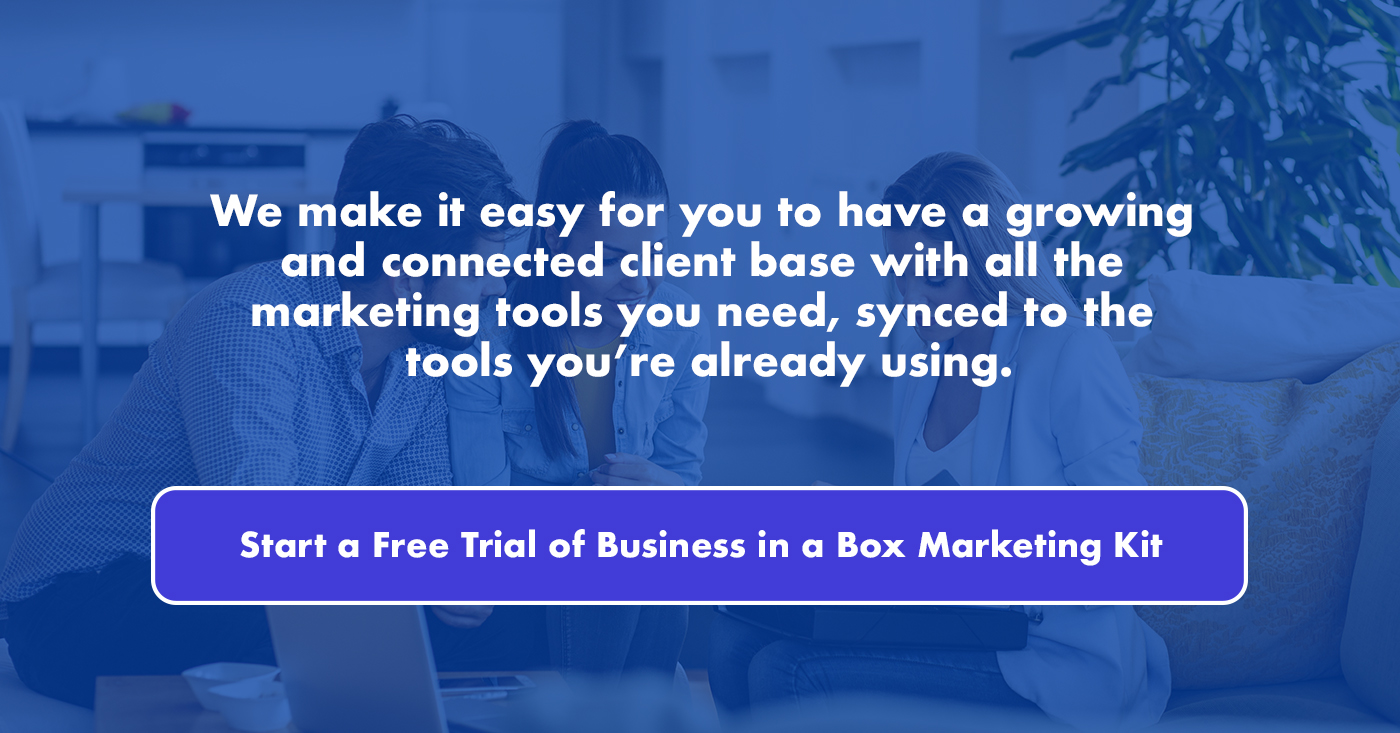Finding that perfect new employee to add to your staff can be tough. But after all that work you put into recruiting and closing the deal, it’s what comes next that can really make or break your growing team.
When that new employee shows up for their first day, they begin the process of getting to know the team and your company’s culture, understanding their role, setting up their tools, and getting settled into their work. It’s not unusual for this process to take months, as there’s a lot to learn.
If you ignore employee onboarding and let them figure things out for themselves, this process will take a lot longer than it would if you were to guide them through it.
Relying on some key onboarding best practices, as figured out by leading companies, can make all the difference in the world.
Related: How To Develop Powerful Business Core Values and Mission Statements
Lack of onboarding or a process that doesn’t go smoothly can leave employees feeling overwhelmed, confused, and unsupported in their new roles. Even worse, it can mean losing employees because they never find their place in the company.
According to HR consulting firm Wynhurst Group, 22% of staff turnover occurs in the first 45 days of employment. The firm also found that new employees who go through a structured onboarding process are 58% more likely to stay with the company for more than three years.
Clearly, this is not something that happens on its own.
To help you develop an effective onboarding process, here are four companies that are doing it right.
Onboarding Best Practices: Who’s getting it right?
The following companies have created onboarding processes that encourage new employees to become part of the team, get to know the culture they’re stepping into, and hit the ground running from day one. Follow some of these onboarding best practices to maximize success with new hires.
Fog Creek Onboarding
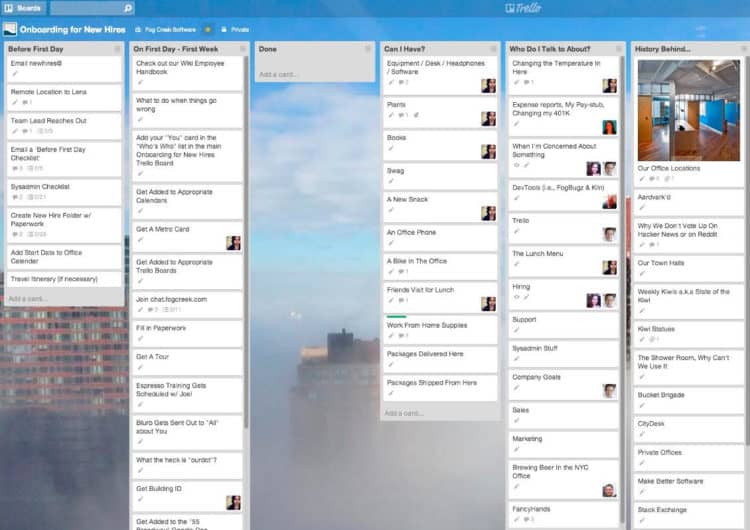
The team at Fog Creek uses Trello for onboarding new hires. The process is based on a template Trello board containing task cards for the new employee and for other team members to complete.
The board is split into lists of tasks, each with a different focus. There’s a list of tasks that need to be done beforehand, for the new hire to have a successful first day, such as getting their paperwork ready and adding their start date to the office calendar.
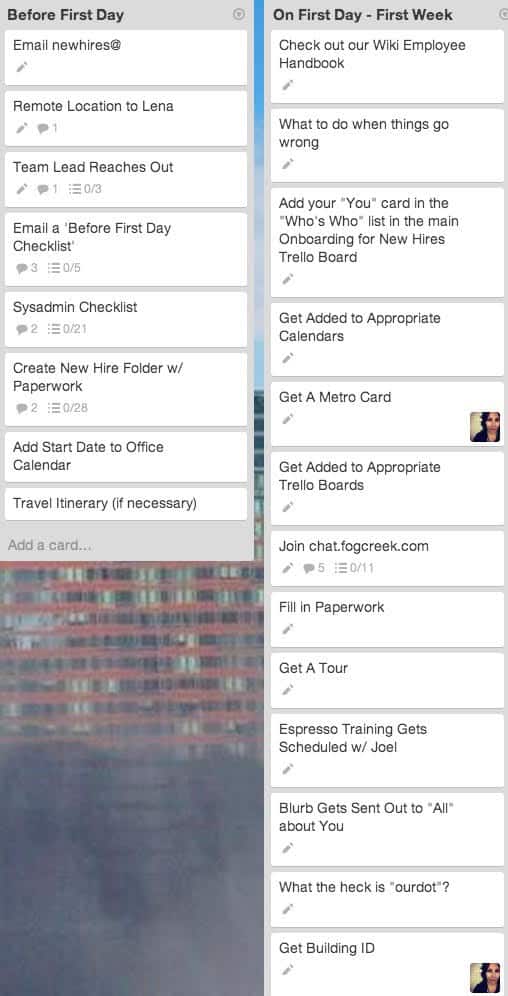
There’s also a list full of first-day and first-week tasks. Most of these are for the new hire to complete, and they can work through them at their own pace. This section includes things like joining the team’s calendars and internal chat room, completing paperwork, and adding themselves to the onboarding Trello board’s “Who’s Who” section.
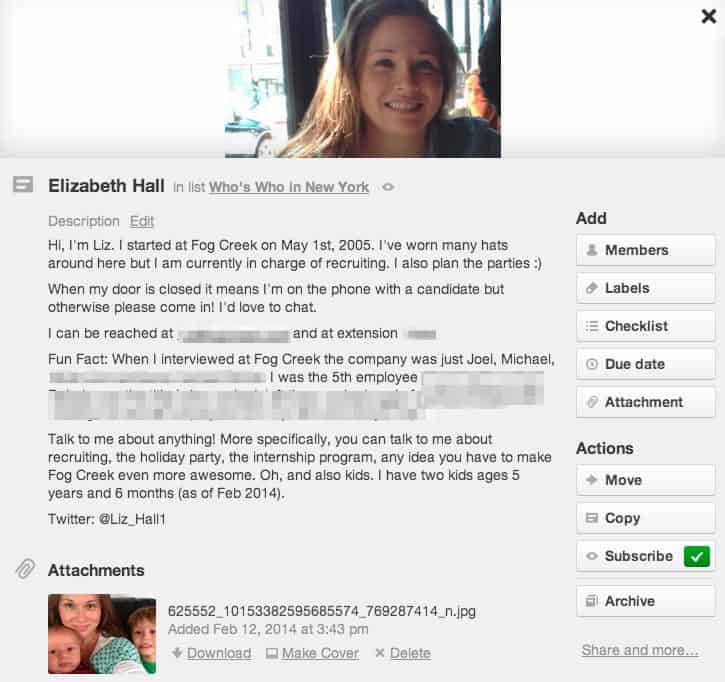
The “Who’s Who” list is part of an FAQ section designed to answer questions new employees might have. There are two “Who’re Who” lists—one for employees in the New York office and one for remote employees. Each team member has their own card on one of these lists with a photo and details about what they do at Fog Creek.
Other lists in the FAQ section of the board include “Can I Have?” with cards about snacks, plants, and bikes in the office; “Who Do I Talk To About?” with cards on the lunch menu, hiring, and company goals; and “History Behind…” with cards explaining the company’s culture.

One of the biggest benefits of this approach, according to Fog Creek employee Liz Hall, is the clarity of the process. Before they used Trello to organize the onboarding process, it fell apart if a key employee was out of the office when a new hire showed up. Now the process is laid out clearly so anyone can jump in and get a new employee up to speed.
Giving each employee their own copy of this Trello board also lets Liz keep an eye on their progress as they work through the tasks.
Fog Creek Onboarding Takeaways
1. Preempt questions a new hire will have and prepare answers ahead of time. Fog Creek’s Trello board includes answers to questions most new employees will have. As each new employee joins your team, take note of any questions they have that aren’t answered in your onboarding process and update them on a regular basis.
2. Assign team members to each part of the onboarding process. Part of what makes Fog Creek’s process so smooth is that everyone has a role to play, and they know what it is. If you need multiple people involved to onboard a new team member, ensure everyone knows their own role and who else is involved in the process. Planning responsibilities ahead of time will avoid wasting time figuring it out later and making a bad impression on your new hire.
3. Make your onboarding process transparent. As Fog Creek found, keeping information locked up in people’s heads makes for a frustrating experience. When you plan your onboarding experience, put as much information as possible into the public domain where new employees and existing team members can access it. This way, you won’t have to worry about people leaving the company with key knowledge or being unavailable during a new team member’s onboarding.
Percolate Onboarding
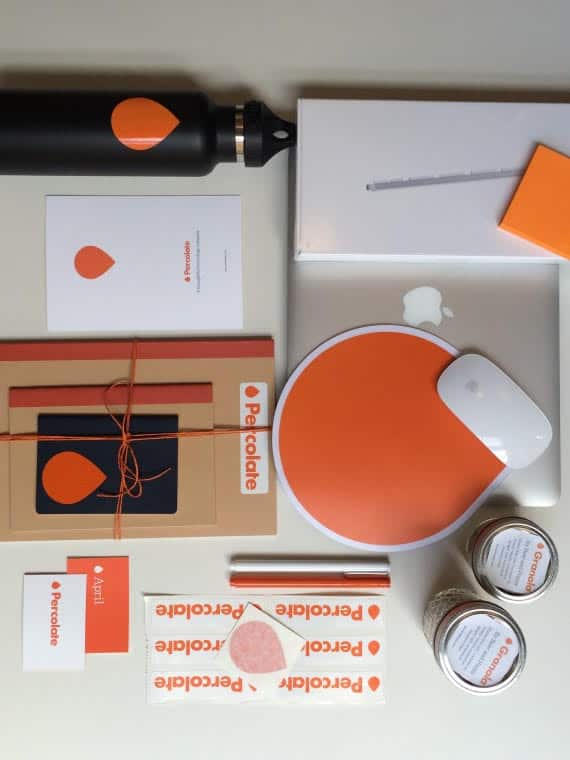
Percolate uses a similar process to Fog Creek’s Trello board, assigning tasks to new hires in Asana so they know what to do when they arrive. One of these tasks is to read an 18-page Google Doc about the company’s history, culture, and values, as well as practical advice about things like running effective meetings and setting up strong passwords.
This long document, called “Day One @ Percolate,” also points new team members to important onboarding docs like the company’s internal wiki, a vocabulary of internal terms, and an employee manual.
Aside from all the reading, another early task for new hires is to send a company-wide email introducing themselves. There are rules about what this email should include, such as where you grew up, what you were doing professionally before Percolate, and at least a few random/personal tidbits, as well as an embarrassing photo of yourself.
Percolate also uses a buddy system to help new employees get to know the company quickly. The buddy, known as a “Percolator,” will check on the new hire as they get settled in, take them out for lunch, and answer questions. They’ll also take the new employee on a tour of the office and introduce them to the rest of the team.
Percolate Onboarding Takeaways
1. Get new team members up to speed on internal jargon. We all get used to using particular terms within our company, and it’s easy to forget that these words mean nothing to new team members. Avoid making new employees feel left out and confused by putting together a vocab sheet to bring them up to speed. Don’t forget to review it on a regular basis to make sure any newly coined terms are included.
2. Formalize the process of introducing new employees to the team. It’s always awkward to join a group of tight-knit people who know each other well. The last thing you want is for a new team member to feel uncomfortable, so set out a specific way for them to be introduced and get to know their colleagues. Making this a formal process will take away the nerves of a new team members figuring it out for themselves, and will let existing employees know what to expect.
At Bonobos, the hiring manager emails everyone in the company to introduce their new hire. They also include three facts about the newbie—one of which is a lie. The first person to correctly guess the lie wins $25 in store credit, and team members are encouraged to talk to the new employee to figure out which of the facts are true.

At Birchbox, a simple flag is placed on each new employee’s desk that says “Say hi, I’m new” to encourage team members to get to know new employees.
3. Assign someone to answer questions for your new hire. Another awkward part of settling into a new team is figuring out how things work. You’ll never be able to preempt every question your new hires will have, so make sure someone’s responsible for answering questions and helping them find their way. This will remove the discomfort of interrupting colleagues by setting expectations that someone will be available.
Zappos Onboarding
Everyone who joins the Zappos team starts with four weeks of customer service training. From executives to developers, every team member is instilled with the Zappos mission to “deliver wow through service.”
For anyone who struggles with customer service training, that’s a red flag that they’re not a good culture fit for Zappos. Although candidates are made aware of the four-week training during the recruitment process, sometimes they need to go through it to realize the customer-focused culture of Zappos isn’t for them.
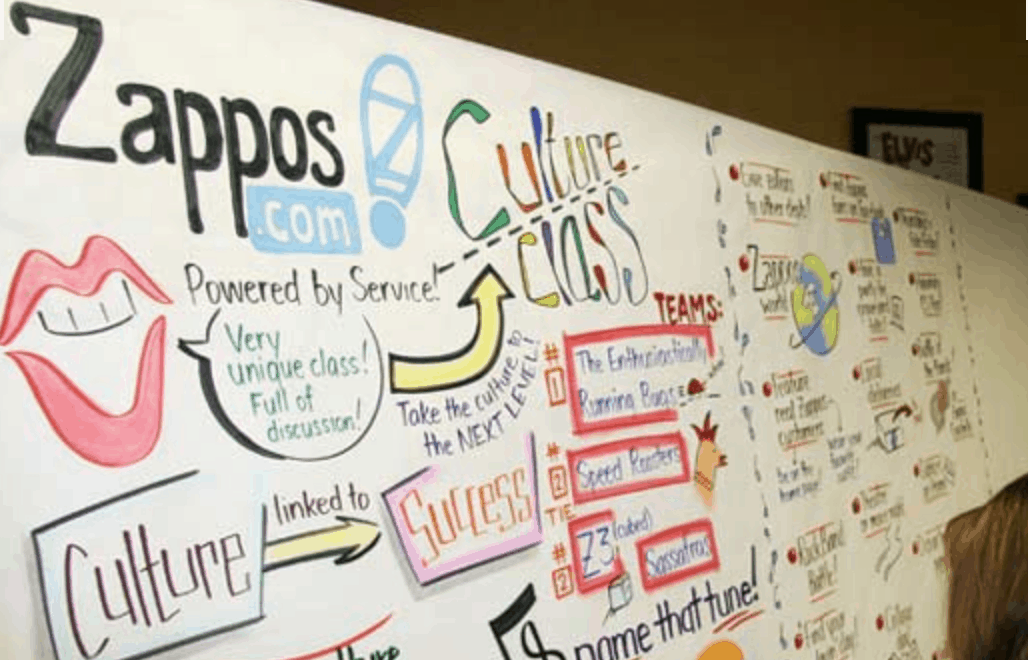
This training process also shows new employees how important the customer-facing roles in the company are, imbuing a sense of respect for the team members who stay in the service area once the training is finished (new customer service reps spend an extra three weeks training after the initial four-week stint).
When all new employees experience the role of a customer service rep, they’re able to feel more empathy with both customers and their colleagues. It might seem like a heavy investment to spend a full four weeks on training each employee in an area most of them weren’t hired for, but it often pays off in unexpected ways.
Software engineer Mark Madej says having developers spend time in customer service gives them hands-on experience with the complexity of the systems their colleagues used every day and even inspired some Zappos developers to create a more streamlined solution. “We wouldn’t have come up with that if we hadn’t been on the phone with customers and seen the problem for ourselves,” he told Inc. “That’s how you invest money in training and see real-time results.”
One onboarding tactic that Zappos has become famous for is “The Offer.” When new employees finish the training period, they’ve offered a payout to leave the company. The amount has grown from $2,000 to $4,000 and continues to fluctuate with the economy, but it’s designed to be enough that the financial pressure of being unemployed won’t make someone stay at Zappos if they feel they’re not a good culture fit.
Employees have three weeks to try out their new role before deciding whether to stay on or take the payout and leave.
Zappos Onboarding Takeaways
1. Set clear expectations from the beginning. You don’t want to waste your time onboarding someone who’s clearly a bad fit for your company. Avoid this by being upfront during the hiring process—not just about the role, but about what your onboarding process involves, especially if it’s as elaborate as the one at Zappos.
2. Give new employees a real taste of their role during onboarding. When you’re onboarding a new team member, that’s their chance to get to know the company *and* to feel out the role. You need to know they’re up to the task you’ve hired them for, and they need to know they’ll be fulfilled and motivated in the role they’re taking on. Try to make your onboarding process reflect normal workdays in the office as much as possible, so your new employee doesn’t get a shock when onboarding is over and the real work begins.
Whole Foods Onboarding
Whole Foods has an interesting ritual that takes place after a new employee has been with the company for 90 days. The rest of the team gets to vote on whether or not the new hire should stay.
The new hire needs a two-thirds majority vote in their favor to keep their place on the team. Each team within the company conducts the voting differently—some use email while some do a simple in-person count while the new employee is out of the room.
As part of a profit-sharing model, Whole Foods employees receive quarterly bonuses if their team meets internal goals. This gives the employees a “sense of shared fate,” and the voting ritual encourages new hires to build strong relationships with other team members and pull their weight during their first 90 days with the company.
Whole Foods Onboarding Takeaways
1. Give team members a say in who you hire. You don’t need to take as drastic a stance as Whole Foods, but it’s worth listening to the people your new employee will work with every day. At the end of the onboarding process, ask your team members how they get along with the new hire and whether they believe they’re a good culture fit. You can’t listen in on every interaction your new employee has, so this is a good way to get a feel for how well they’re settling in.
More Ways to Make Employee Onboarding a Breeze
Carly Guthrie shared her advice for onboarding employees in an interview, based on her 15 years of experience in HR. Her rules for making a new hire’s first day perfect are:
1. Never start a new employee at 9 a.m.—start them at 11 so you have time to get organized first and be ready to help them when they arrive.
2. Don’t outsource a welcome—have the new hire’s manager be the one to show them around and introduce them to the team.
3. Take it easy on day one—Guthrie says it’s important to acknowledge that first-day nerves mean most employees don’t sleep well the night before starting a new job. Keep their workload light to account for this. She also suggests making sure they don’t have long days in their first week, since they need plenty of time to relax and reflect on all the new information coming at them.
Guthrie also suggests making sure existing team members know to proactively introduce themselves to new hires and to explain what they do within the company to help new employees understand the big picture as they meet new people.
If you want to go the extra mile, Guthrie suggests offering swag for the employee’s family, setting up their new hardware with the software they’ll need before they arrive, and preparing their first-week schedule ahead of time so you can tell them on day one who they’re having lunch with and what meetings they’ll be going to throughout the whole first week.
Another common approach to welcoming a new employee is to include a company-specific gift in their welcome pack. ZenPayroll gives new employees a watermelon as a throwback to the gift the original founders were given by the landlord of their first office.
At Warby Parker, the welcome pack for newbies includes Jack Kerouac’s “Dharma Bums,” because the company was named after Kerouac characters; Martin’s Pretzels, because the founders ate them a lot when starting the company; and a gift certificate for a Thai restaurant, because the founders used to eat late-night Thai dinners when nothing else was open after long days of work.
And don’t forget the anxiety of being a new face in an established team—it’s important to build strong relationships at work, but integrating socially can be scary when you’re new.
Warby Parker aims to ease this process with a tool called Lunch Roulette. Every week, the tool randomly selects two groups of four employees to have lunch together on the company’s dime. The groups never include more than one employee from each department to encourage inter-department relationships.
_______
You can see from these examples that onboarding done right takes time, effort, and even some creativity. But when you put months, and thousands of dollars, into hiring the right person for your company, it’s wasteful to throw all that effort away by leaving them to sink or swim when they arrive.
Given the statistical payoff of a successful onboarding process, a little extra time and effort during these first few weeks could easily pay for itself in loyalty and employee happiness later on.
Image credits: Birchbox flag via New York Times. Trello images via Fog Creek. Percolate gear via Percolate.




